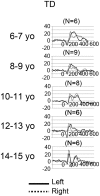Missing and delayed auditory responses in young and older children with autism spectrum disorders
- PMID: 24936181
- PMCID: PMC4047517
- DOI: 10.3389/fnhum.2014.00417
Missing and delayed auditory responses in young and older children with autism spectrum disorders
Abstract
Background: The development of left and right superior temporal gyrus (STG) 50 ms (M50) and 100 ms (M100) auditory responses in typically developing (TD) children and in children with autism spectrum disorder (ASD) was examined. Reflecting differential development of primary/secondary auditory areas and supporting previous studies, it was hypothesized that whereas left and right M50 STG responses would be observed equally often in younger and older children, left and right M100 STG responses would more often be absent in younger than older children. In ASD, delayed neurodevelopment would be indicated via the observation of a greater proportion of ASD than TD subjects showing missing M100 but not M50 responses in both age groups. Missing M100 responses would be observed primarily in children with ASD with language impairment (ASD + LI) (and perhaps concomitantly lower general cognitive abilities).
Methods: Thirty-five TD controls, 63 ASD without language impairment (ASD - LI), and 38 ASD + LI were recruited. Binaural tones were presented. The presence or absence of a STG M50 and M100 was scored. Subjects were grouped into younger (6-10 years old) and older groups (11-15 years old).
Results: Although M50 responses were observed equally often in older and younger subjects and equally often in TD and ASD, left and right M50 responses were delayed in ASD - LI and ASD + LI. Group comparisons showed that in younger subjects M100 responses were observed more often in TD than ASD + LI (90 versus 66%, p = 0.04), with no differences between TD and ASD - LI (90 versus 76%, p = 0.14) or between ASD - LI and ASD + LI (76 versus 66%, p = 0.53). In older subjects, whereas no differences were observed between TD and ASD + LI, responses were observed more often in ASD - LI than ASD + LI. Findings were similar when splitting the ASD group into lower- and higher-cognitive functioning groups.
Conclusion: Although present in all groups, M50 responses were delayed in ASD. Examining the TD data, findings indicated that by 11 years, a right M100 should be observed in 100% of subjects and a left M100 in 80% of subjects. Thus, by 11 years, lack of a left and especially right M100 offers neurobiological insight into sensory processing that may underlie language or cognitive impairment.
Keywords: M100; M50; autism spectrum disorders; magnetoencephalography; superior temporal gyrus.
Figures



Similar articles
-
Delayed Auditory Evoked Responses in Autism Spectrum Disorder across the Life Span.Dev Neurosci. 2019;41(3-4):223-233. doi: 10.1159/000504960. Epub 2020 Jan 31. Dev Neurosci. 2019. PMID: 32007990 Free PMC article.
-
Delayed M50/M100 evoked response component latency in minimally verbal/nonverbal children who have autism spectrum disorder.Mol Autism. 2019 Aug 15;10:34. doi: 10.1186/s13229-019-0283-3. eCollection 2019. Mol Autism. 2019. PMID: 31428297 Free PMC article.
-
MEG detection of delayed auditory evoked responses in autism spectrum disorders: towards an imaging biomarker for autism.Autism Res. 2010 Feb;3(1):8-18. doi: 10.1002/aur.111. Autism Res. 2010. PMID: 20063319 Free PMC article.
-
Biomarkers for autism spectrum disorder: opportunities for magnetoencephalography (MEG).J Neurodev Disord. 2021 Sep 15;13(1):34. doi: 10.1186/s11689-021-09385-y. J Neurodev Disord. 2021. PMID: 34525943 Free PMC article. Review.
-
Magnetoencephalography Research in Pediatric Autism Spectrum Disorder.Neuroimaging Clin N Am. 2020 May;30(2):193-203. doi: 10.1016/j.nic.2020.01.001. Epub 2020 Mar 27. Neuroimaging Clin N Am. 2020. PMID: 32336406 Free PMC article. Review.
Cited by
-
Deficits in auditory processing contribute to impairments in vocal affect recognition in autism spectrum disorders: A MEG study.Neuropsychology. 2015 Nov;29(6):895-908. doi: 10.1037/neu0000209. Epub 2015 May 25. Neuropsychology. 2015. PMID: 26011112 Free PMC article.
-
Auditory encoding abnormalities in children with autism spectrum disorder suggest delayed development of auditory cortex.Mol Autism. 2015 Dec 30;6:69. doi: 10.1186/s13229-015-0065-5. eCollection 2015. Mol Autism. 2015. PMID: 26719787 Free PMC article.
-
Prospective MEG biomarkers in ASD: pre-clinical evidence and clinical promise of electrophysiological signatures.Yale J Biol Med. 2015 Mar 4;88(1):25-36. eCollection 2015 Mar. Yale J Biol Med. 2015. PMID: 25745372 Free PMC article. Review.
-
Synchrony of auditory brain responses predicts behavioral ability to keep still in children with autism spectrum disorder: Auditory-evoked response in children with autism spectrum disorder.Neuroimage Clin. 2016 Jul 22;12:300-5. doi: 10.1016/j.nicl.2016.07.009. eCollection 2016. Neuroimage Clin. 2016. PMID: 27551667 Free PMC article.
-
Magnetoencephalographic Imaging of Auditory and Somatosensory Cortical Responses in Children with Autism and Sensory Processing Dysfunction.Front Hum Neurosci. 2017 May 26;11:259. doi: 10.3389/fnhum.2017.00259. eCollection 2017. Front Hum Neurosci. 2017. PMID: 28603492 Free PMC article.
References
Grants and funding
LinkOut - more resources
Full Text Sources
Other Literature Sources

